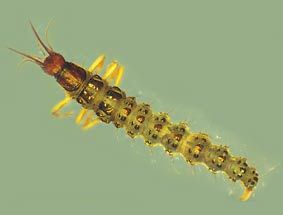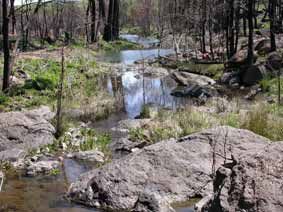Major Group: Insecta
Order: Neuroptera
Family: Osmylidae |
Descriptive Features: campodeiform, elongate and generally slender
long slender jaws about 2-3 times length of head capsule, and extending straight forward from head
head relatively short, about same width as thorax
antennae slender, length about 2-2 ½ X width of head capsule, multisegmented or with strong secondary annulations
mandibles/maxillae slender, extending straight anteriorly or very slightly convergent medially towards apex, length usually about 3X head width, 6 stemmata
thorax and abdomen with few dorsal and lateral setae, often on slight raised prominences (sometimes with dark, sclerotized bases) or lobes
abdomen tapered toward apex, without ventral abdominal gills
Total length:
|

|
Kempynus sp. |
|
|
|
Taxonomic Checklist: Genera
Australysmus Kimmins 4 species
Clydosmylus montanus New
Kempynus Navás 7 species |
|
Distribution: SE Vic, SE NSW, Qld, ACT
Sensitivity Rating: SIGNAL grade 7
Functional Feeding Group: predators |

|
Molonglo River, Coppins Crossing ACT |
|
|
Ecology: Instream habitat: Only some Osmylidae species are aquatic. Larvae are usually found under rocks and in leaf litter along the margins of streams and lakes. Adults, commonly known as ‘lacewings’, are occasionally found in groups on rocks or under bridges near water.
Feeding ecology: Larvae are predators feeding on a variety of insects, with the more aquatic species believed to probe the mud with their proboscis looking for chironomid larvae. However, a number of individuals have been recorded with plant material in their gut contents.
Habit: Some osmylid larvae have water repellent surfaces to prevent them from sinking through the water surface.
Life history: Little is known of the biology of Australian Osmylidae species so much of the following information is from Northern hemisphere records. Females lay their eggs in short rows of up to 12 on overhanging vegetation, tree trunks or stones. Larvae pass through three instars. Pupation takes place on land and lasts for 7-18 days. Most Osmylidae species appear to be univoltine, with adults emerging in summer or autumn. Adults may live for two weeks or up to three months.
|
| |
Information Sources: New 1991, 1995, 2004, Williams & Feltmate 1992, Williams 1980, Gooderham & Tsyrlin 2002, Merritt & Cummins 1996
Key to Genera: none
Key to Species: Australian aquatic larvae have not been formally described at species level (New 2004) |
|
|
|